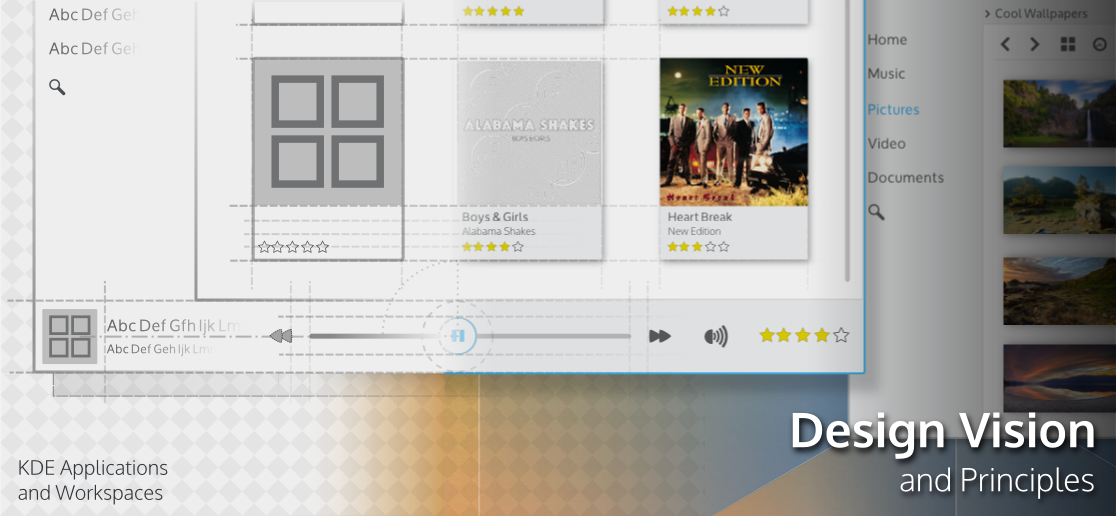Projects/Usability/HIG/Presentation/DesignVisionPrinciples: Difference between revisions
mNo edit summary |
|||
| (6 intermediate revisions by the same user not shown) | |||
| Line 1: | Line 1: | ||
__NOTOC__ | __NOTOC__ | ||
=Design Vision and Principles= | |||
[[File:HIGDesignVisionFullBleed.png]] | [[File:HIGDesignVisionFullBleed.png]] | ||
<div style="text-align: center;">''Simple by default, powerful when needed.''</div> | <div style="text-align: center;">''Simple by default, powerful when needed.''</div> | ||
Design is driven at the highest level by a vision. We rely on a set of design principles to fulfill that design vision. These principles guide all aspects of the user interface design. | Design is driven at the highest level by a vision. We rely on a set of design principles to fulfill that design vision. These principles guide all aspects of the user interface design. | ||
== Design Vision == | |||
The design vision is focused on two attributes of KDE software that connect its past to its future. | |||
The design vision is focused on two attributes of KDE | |||
* ''Simple by | * ''Simple by default'' - Simple and inviting. KDE software is pleasant to experience and easy to use. | ||
* ''Powerful when needed'' - Power and flexibility. KDE | * ''Powerful when needed'' - Power and flexibility. KDE software allows users to be effortlessly creative and efficiently productive. | ||
== Design Principles == | |||
The following design principles are used in support of the Design Vision. | The following design principles are used in support of the Design Vision. | ||
*Simple by | *Simple by default | ||
** ''Make it easy to focus on what matters.'' - Remove or minimize elements not crucial to the primary task. Use spacing to keep things uncluttered. Use color to draw attention. Reveal additional information or optional functions when needed, not before. | ** ''Make it easy to focus on what matters.'' - Remove or minimize elements not crucial to the primary task. Use spacing to keep things uncluttered. Use color to draw attention. Reveal additional information or optional functions when needed, not before. | ||
** ''I know how to do that!'' - Make things easier to learn by reusing design patterns from other applications. | ** ''I know how to do that!'' - Make things easier to learn by reusing design patterns from other applications. | ||
** ''Do the heavy lifting for me.'' - Make complex tasks simple. Make novices feel like experts. | ** ''Do the heavy lifting for me.'' - Make complex tasks simple. Make novices feel like experts. | ||
*Powerful when | *Powerful when needed | ||
** ''Solve a problem.'' - Identify and make very clear to the user what need is addressed and how. | ** ''Solve a problem.'' - Identify and make very clear to the user what need is addressed and how. | ||
** ''Always in control.'' - It should always be clear what can be done, what is happening and what happened. The user should never feel at the mercy of the tool. Give the user the final say. | ** ''Always in control.'' - It should always be clear what can be done, what is happening and what happened. The user should never feel at the mercy of the tool. Give the user the final say. | ||
** ''Be flexible.'' - Provide sensible defaults but consider optional functionality or customizations that do not interfere with the primary task. | ** ''Be flexible.'' - Provide sensible defaults but consider optional functionality or customizations that do not interfere with the primary task. | ||
{{Prevnext2|nextpage=Projects/Usability/HIG/Concept|nexttext=Concept|index=Projects/Usability/HIG#Getting_Started|indextext=Back to Getting Started}} | |||
<span style="font-size: 85%">Elements of these guidelines have been adapted, per license, from [https://developer.android.com/design/index.html Android Design].</span> | <span style="font-size: 85%">Elements of these guidelines have been adapted, per license, from [https://developer.android.com/design/index.html Android Design].</span> | ||
[[Category:Usability]] | [[Category:Usability]] | ||
Revision as of 17:31, 28 September 2014
Design Vision and Principles
Simple by default, powerful when needed.
Design is driven at the highest level by a vision. We rely on a set of design principles to fulfill that design vision. These principles guide all aspects of the user interface design.
Design Vision
The design vision is focused on two attributes of KDE software that connect its past to its future.
- Simple by default - Simple and inviting. KDE software is pleasant to experience and easy to use.
- Powerful when needed - Power and flexibility. KDE software allows users to be effortlessly creative and efficiently productive.
Design Principles
The following design principles are used in support of the Design Vision.
- Simple by default
- Make it easy to focus on what matters. - Remove or minimize elements not crucial to the primary task. Use spacing to keep things uncluttered. Use color to draw attention. Reveal additional information or optional functions when needed, not before.
- I know how to do that! - Make things easier to learn by reusing design patterns from other applications.
- Do the heavy lifting for me. - Make complex tasks simple. Make novices feel like experts.
- Powerful when needed
- Solve a problem. - Identify and make very clear to the user what need is addressed and how.
- Always in control. - It should always be clear what can be done, what is happening and what happened. The user should never feel at the mercy of the tool. Give the user the final say.
- Be flexible. - Provide sensible defaults but consider optional functionality or customizations that do not interfere with the primary task.
Elements of these guidelines have been adapted, per license, from Android Design.

